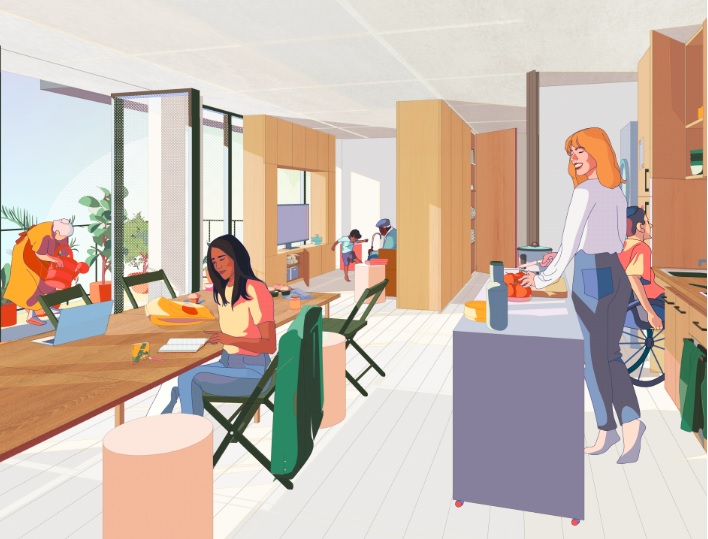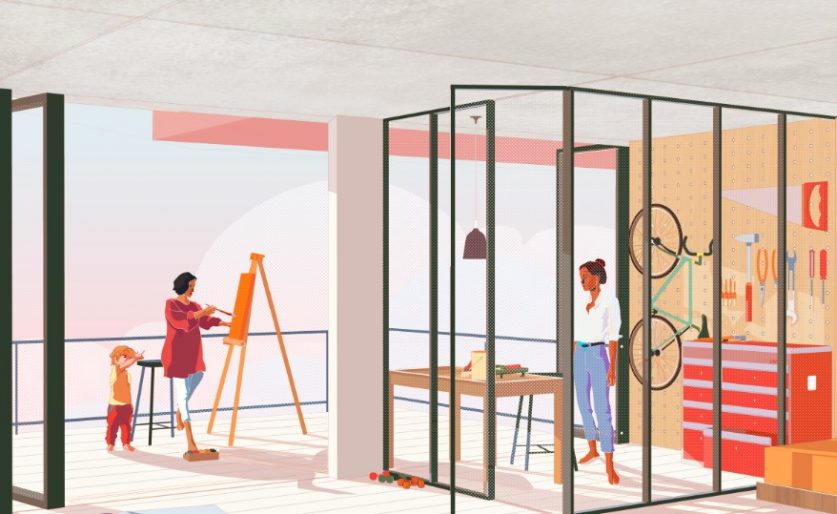Multi-residential buildings have been the subject of considerable discord since coronavirus restrictions forced millions to stay at home. How tenants would survive months of arduous lock-down in dense congregate living settings seemed unimaginable—especially for those confined to units without access to the outdoors. Now, as restrictions lift and the country resumes to a comparative state of normalcy, designers and developers are looking at the future through a new, albeit, slightly blurry lens.
“As city builders, we have a tremendous opportunity to learn from this experience and make positive changes to the way we design our residential buildings that extend beyond limiting the spread of infectious disease,” says Dev Mehta, Senior Associate at Quadrangle. “It has taught us that there are several aspects to the way we have been designing and constructing residential buildings that can be optimized to create healthier spaces.”
Like many, Mehta believes the pandemic has accelerated several trends that will continue to disrupt the way we consider uses in our built environment—namely, our enhanced appetite for online consumption and our newly distributed work force. These, among other trends, have further emphasized the need for buildings that better support a “live, work and play at home” existence. But that doesn’t necessarily mean the appeal of the downtown core will diminish.
“Though some are predicting there will be a reaction for many to consider moving away from denser urban centres and adopt a suburban lifestyle, it is unlikely that this will happen to a significant extent,” Mehta says. “The desire to live in dense, diverse and transit-oriented cities will very likely continue to increase in momentum in the long term, given the many benefits that these kinds of spaces offer.”
Pointing to current data, Mehta conjectures that density is not the major culprit for the spread of COVID-19, rather it is human behaviour and clarity around government messaging and policy decisions. “Because demand in many of our sought-after urban centres will likely continue to rise and surpass the available supply, affordability will continue to be an issue,” he says. “So, simply lowering the density of new developments and increasing the size of units will not be an option for the majority of private-sector funded developments. What we will instead need to consider is “better density.”
What is better density?
 Better density, according to Mehta, means optimizing the spaces we build to promote certain outcomes. Those are: mental and physical health and well-being; flexibility and adaptability; sustainability and resilience; and affordability and inclusivity.
Better density, according to Mehta, means optimizing the spaces we build to promote certain outcomes. Those are: mental and physical health and well-being; flexibility and adaptability; sustainability and resilience; and affordability and inclusivity.
“We will need to think more creatively and less prescriptively about how we define spaces in our residential buildings and units,” he says. “Unit layouts will have to consider adjustable partition elements that allow users to define and change their space in a way that is more fluid throughout the day. A bedroom is not always a bedroom and a dining space is not always a dining space. We have already overcome this psychological barrier of delineating and rigidly programming our spaces, and architecture will have to catch up to and embrace this.”
Looking at the structural systems, a return to using columns instead of shear walls will allow for easier conversions, as shear walls limits the potential for future interior alterations and adaptive re-use solutions. Also, access to sunlight will emerge as a priority, with sun rooms, balconies and terraces becoming valuable extensions of units. Adding operable facades will provide more meaningful connections to outdoor spaces, blurring inside and outside, while also building in opportunities for urban agriculture and gardening. And should a new deadly virus come along in the not-so-distant future, Mehta’s answer to closing amenities is to introduce a concierge whose duties will include overseeing bookings (and subsequent cleanings) of these essential spaces.
“Access to the outdoors is absolutely crucial to both mental and physical health and well-being,” he says. “Similarly, interior amenity and common gathering spaces will need to remain flexible so that programming can vary over time and respond to whatever the current situation is. Distributed amenity spaces will allow this to happen more fluidly.”
While smaller “pocket” amenity spaces distributed across all floors could allow smaller groups and families to gather, Mehta envisions flexible, grade-related amenities to support building residents and engage the local community.
“Equipped with robust communication and hard infrastructure, these spaces could serve a dual purpose,” he says. “They could be used for everyday social programming and for support programming during climate-related emergencies and pandemics. Services could include a continuous clean water supply, refrigeration for grocery deliveries and other essential supplies, a heating, air conditioning and filtration system to enhance air quality, all backed up on an emergency power supply.”
 Even some of the more functional common spaces, such as corridors, exit stairs and lobbies, could benefit from access to daylight and fresh air—making them more suitable for social interaction and exercise, beyond their main circulation function.
Even some of the more functional common spaces, such as corridors, exit stairs and lobbies, could benefit from access to daylight and fresh air—making them more suitable for social interaction and exercise, beyond their main circulation function.
Retrofitting older buildings
With so many existing multi-unit buildings in dire need of upgrades, it’s not just new builds that are being re-imagined. In fact, Mehta sees the retrofitting of older properties as the most pressing need impacting the sector in the near future. “Upgrading the plumbing and HVAC systems, as well as the building envelopes in older apartment buildings would deliver significant benefits,” he says. “This would provide opportunities to improve air circulation, natural ventilation and access to daylight, which all lead to the improved wellness of occupants and lower chances of airborne infection transmission.”
He also recommends touchless devices and automatic door operators activated by card or fob readers for hands-free roaming within common areas and service spaces, like garbage chutes, as well as improvements to elevator technology for smarter vertical travel.
But more than anything, flexibility is of key importance.
“Technological upgrades will help us flow through our spaces with more ease,” he says, “ but building better density will rely on some fundamental decisions in how we design and lay-out our future buildings.”
With more importance being placed on private outdoor space to allow access to fresh air and sunlight, we may see solutions to provide larger structural cantilevers for more significant private outdoor spaces. With home comfort increasing in importance we may start to see a wider adoption of thermally broken details for balconies to improve thermal comfort and the performance of our buildings. We may also see increased investment in quality insulated building envelopes and glazing systems.
Will striving for better density impact affordability?
Potentially yes—but in a good way.
“There will likely be more interest in modular and prefabricated construction to reduce costs and construction timelines,” says Mehta. “We are already seeing the City of Toronto fast-track modular housing solutions for our homeless population. It is only a matter of time before the private sector embraces this more meaningfully.”
Renderings provided by Quadrangle





